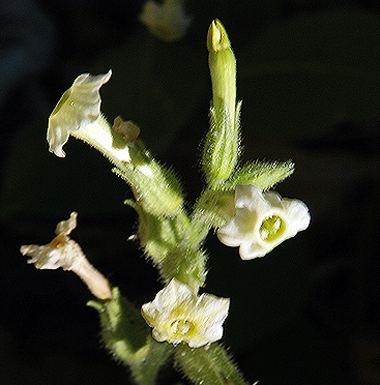|
Digital-Desert :
Mojave Desert
|
| Intro:: Nature:: Map:: Parks:: Points of Interest:: Ghosts & Gold:: Communities:: Roads & Trails:: People & History:: BLOG:: PDF:: Weather:: :?:: glossary |
|
|
Wildflowers:
Photo Guide -
List
Indian TobaccoLobelia inflata L.Indian Tobacco is a herbaceous plant native to eastern and central North America, including parts of the Appalachian region, the Midwest, and extending into parts of the Southwest. Itís known more for its historical medicinal use than for showy flowers, but it still has a quiet presence in meadows and forest clearings. Appearance: This annual or biennial herb usually grows 1 to 3 feet tall. It has light green, hairy stems and soft, toothed leaves. The small, pale blue to violet flowers grow along the upper part of the stem. After flowering, the plant develops inflated seed podsóhence the name inflata. Habitat: Found in open woods, fields, clearings, and roadsides. Prefers well-drained soils and partial to full sun. Bloom Time: Summer into early fall, usually from July through September. Traditional Use: Used extensively in traditional Native American medicine and 19th-century herbal remedies, especially as a respiratory aid and to induce vomiting (hence one of its older names, "puke weed"). Due to its potency, it was used with caution. Modern herbalists rarely recommend it due to its toxicity in large amounts. Note: Indian Tobacco isnít commonly found in desert regions but is an important plant historically. Itís a good example of how many native species were used with great care and knowledge by earlier cultures. |
 Indian tobacco |
| Intro:: Nature:: Map:: Parks:: Points of Interest:: Ghosts & Gold:: Communities:: Roads & Trails:: People & History:: BLOG:: PDF:: Weather:: :?:: glossary |
|
Digital-Desert :
Mojave Desert
|
|
Country Life Realty Wrightwood, Ca. |
Mountain Hardware Wrightwood, Ca. |
Canyon Cartography |
G.A. Mercantile |
Grizzly Cafe Family Dining |
|
Abraxas Engineering privacy |
These items are historical in scope and are intended for educational purposes only; they are not meant as an aid for travel planning. Copyright ©Walter Feller. 1995-2025 - All rights reserved. |